A comforting bowl of ramen just isn’t complete without the richness a ramen egg provides. The egg is perhaps THE toughest component of a ramen dish to cook well. Below we feature 3 methods to prepare the perfect ajitama, or Japanese soy sauce eggs, with or without a sous vide to take your ramen to the next level.
Keep reading for the perfect sous vide ramen egg, the perfect steamed egg for ramen, and the perfect soft boiled egg for ramen.
What we’re after is a savory and sweet marinated egg with a soft but solid white and a jammy slightest bit runny yolk. What we won’t accept is a hard boiled egg ruining that delicious ramen.
If you prefer your ramen eggs have a custard like yolk wrapped in a runny silky soft white, you should check out our recipe for an onsen egg, which Momofuku Noodle Bar has popularized for ramen stateside. Otherwise, keep reading. You’re in the right place for traditional ramen eggs.
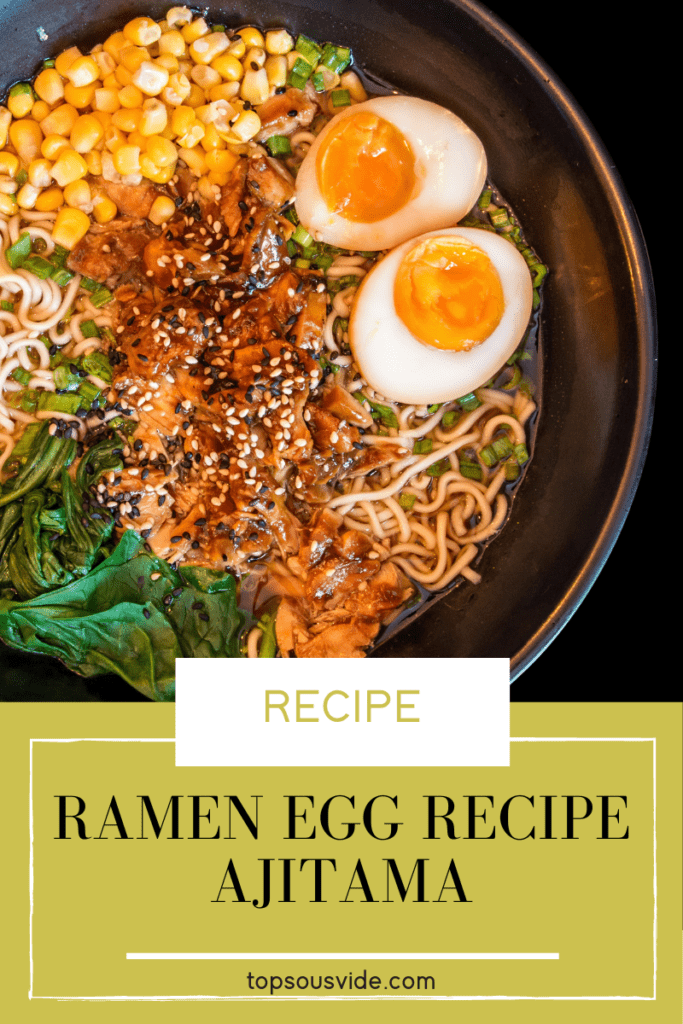
Table of Contents
What is Ajitama?
Ajitama is actually short for Ajitsuke Tamago. In Japanese, ajitsuke means flavor and tamago means egg.
Ajitama is a Japanese preparation for savory and sweet soy sauce marinated soft boiled eggs. The egg white is a bouncy (not rubbery) solid and the yolk is jammy. The eggs absorb the marinade, leaving the outside with a soft brown hue.
Chicken eggs are usually used for ajitama, but quail eggs and duck eggs are also used. Fun fact, at Japanese markets you can find eggs from chickens raised to produce deep golden reddish yolks; Red foods like paprika and red pepper are a mainstay of the chickens’ diet.
Other Names for Ajitama
As we mentioned earlier, ajitama is a contraction of ajitsuke tamago. In the west, these eggs are also known as soy sauce eggs and shoyu eggs. Other Japanese names used for ajitama include nitamago and hanjuku tamago.
What Do You Eat Ajitama With?
Ajitama are commonly used for a ramen topping but can be used for so much more! Eggs are a super food after all. In Japan, they are commonly served as a side dish to rice or a bar snack at the izakaya (Japanese tavern).
Enjoy ajitama with toast. Use it to add protein to a salad. Pack it in your kids’ lunch. The possibilities are endless.
How to Make Ajitama
Below, we provide both sous vide and non-sous vide methods for cooking ajitama.
The Eggs
Our instructions below assume the use of four large eggs, as defined by the USDA, which are 2-ounce eggs.

Use Jacques Pepin‘s wisdom and use a thumbtack or pin to poke a hole on the fat end of each egg. This helps the egg keep a uniform shape (no funny flat bottom), protects the egg from cracking while cooking, and makes peeling the egg easier.

You’ll want to use eggs straight out of the fridge, rather than room temperature, because the yolk cooks faster than the white. We use cold eggs because heat will transfer more slowly to the yolk.
Note, the fresher the egg, the longer it will take to cook.
To further complicate things, yolks set at 149-158°F (65-70°C) while whites begin to set at 140-149°F (60-65°C).
To sum it up, yolks cook more quickly, but set at a lower temperature than whites; this presents a challenge to preparing a proper ramen egg.
We’ll conclude each cook of the eggs with an ice bath to cease the egg from continuing to cook from its retained heat. The margin for transitioning from a great to a good to an okay egg is measured in seconds.

Needing to account for all these complexities to produce a bouncy white with a jammy yolk makes sous vide the ideal way to cook these eggs.
Sure, because length of time is a major factor, we’re not using the sous vide in the traditional sense of cooking through to an even temperature. That said, we are creating precisely repeatable conditions, which is what separates sous vide cooking from other methods.
Sous Vide Ajitama
Simply set your sous vide immersion cooker to 194°F (90°C) and cook your eggs straight out of the fridge for precisely 8 minutes and 30 seconds. Move directly to ice bath for ~15 minutes before peeling.

There’s a lot of room to dial in exactly how you prefer your egg across both the time and temperature settings, which will be affected by uncontrollable variables like altitude. The freedom to customize your egg exactly how you like it and the ability to repeat those conditions precisely, makes this our preferred method for cooking ajitama. 194°F (90°C) for 8 minutes and 30 seconds will at the very least be a good place to start.
If you’re in the mood to fully geek out on what these variables are and the science behind them, read Boiling an Egg from our friends at University of Exeter. It may prove useful in tweaking the recipe to your particular conditions to cook the perfect egg. Just don’t say I didn’t warn you that it’s an academic paper.
Steamed Ajitama
Add ~1.5 inches (4cm) of water to a pot. Add steamer basket with plenty of clearance from the water line. Cover and bring water to a rolling boil. Remove cover to add eggs and replace cover to steam for 7 minutes. Move directly to ice bath for ~15 minutes before peeling.
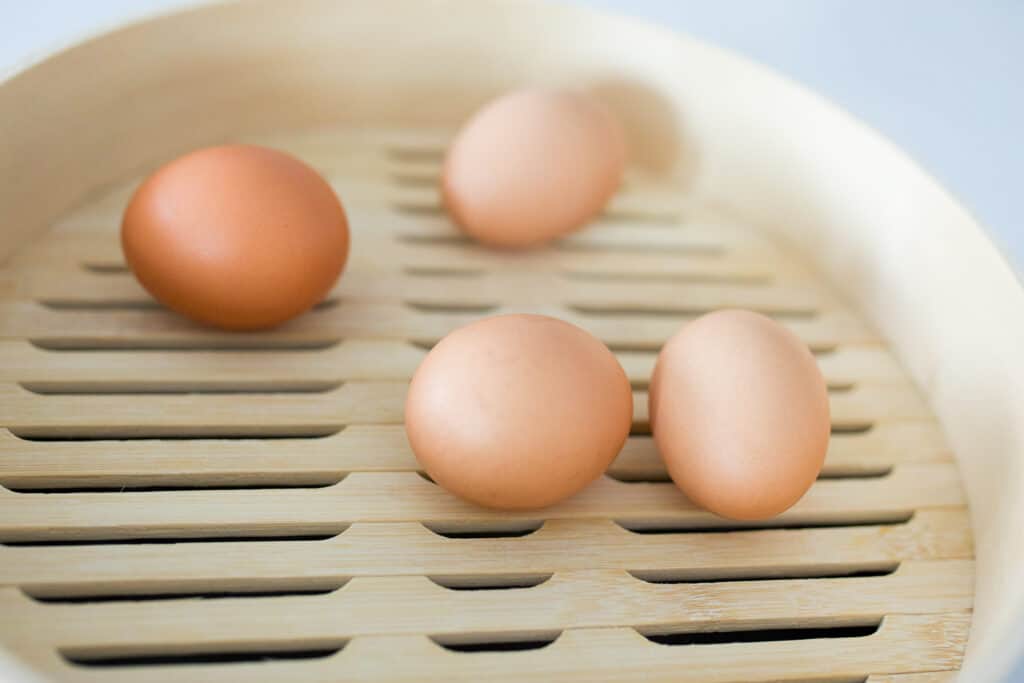
Boiled Ajitama
In a large pot, bring 5 cups of water to a rolling boil. Drop in eggs from the fridge using a slotted spoon and lower the heat to ultimately produce a simmer. Cook precisely for 7 minutes. Move directly to ice bath for ~15 minutes before peeling.
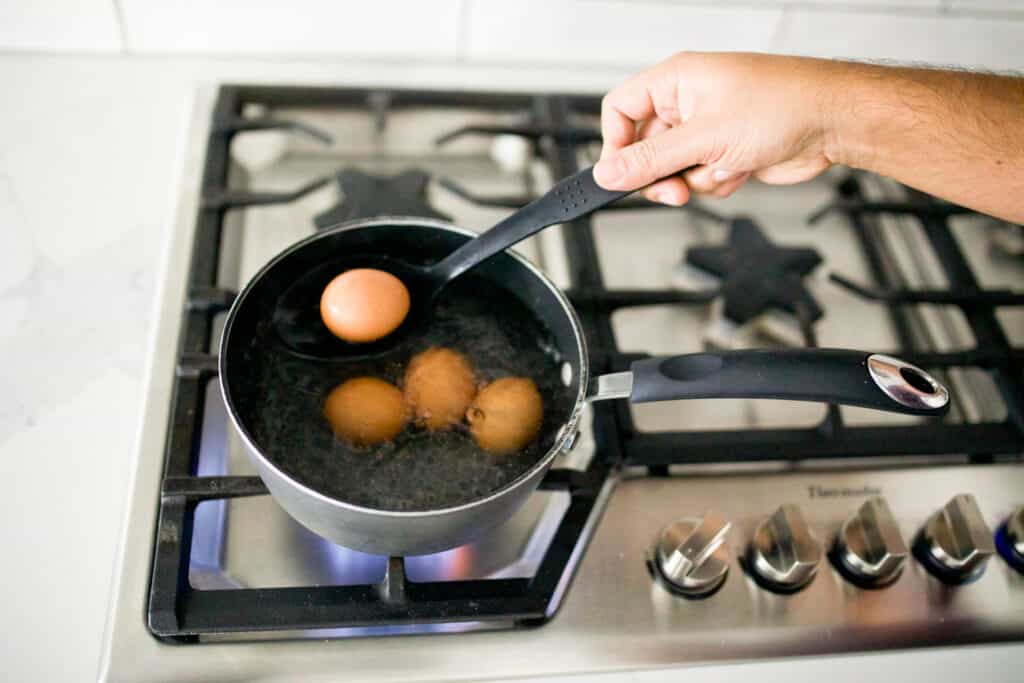
Ajitama Cooking Temperature and Time Chart by Method
| Method | Temperature | Time |
| Sous Vide | 194°F (90°C) | 8.5 minutes |
| Steam | rolling boil (~1.5 inches) | 7 minutes |
| Boil | rolling boil (4 cups), lowered slightly to a simmer | 7 minutes |
Marinade Recipe for Soy Sauce Eggs
We use a simple combination of soy sauce, mirin, sake, a touch of sugar and a clove of garlic. We cook the marinade to burn off the alcohol and to allow the sugar to fully dissolve. We are left with a marinade rich with umami and a touch of sweetness.
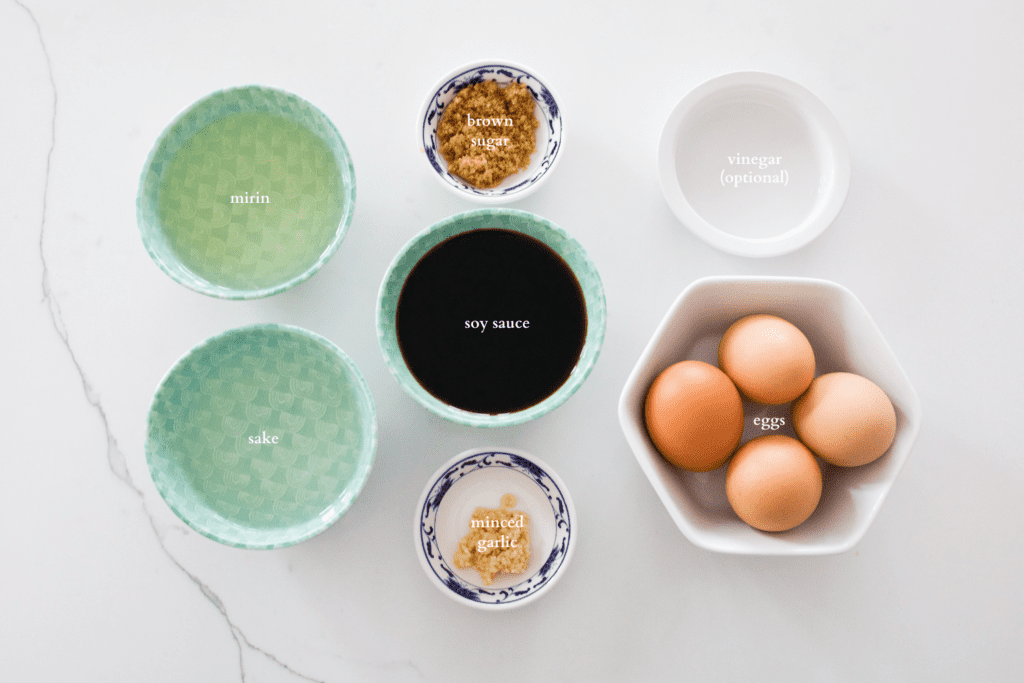
We recommend marinating the eggs for 12 hours. If you marinate the eggs too long, the yolk begins to absorb the salt of the marinade, drying it out. You can dilute the marinade with water if you’d like to keep the eggs marinated longer (e.g. for 24 hours we’d add equal parts water with the marinade).
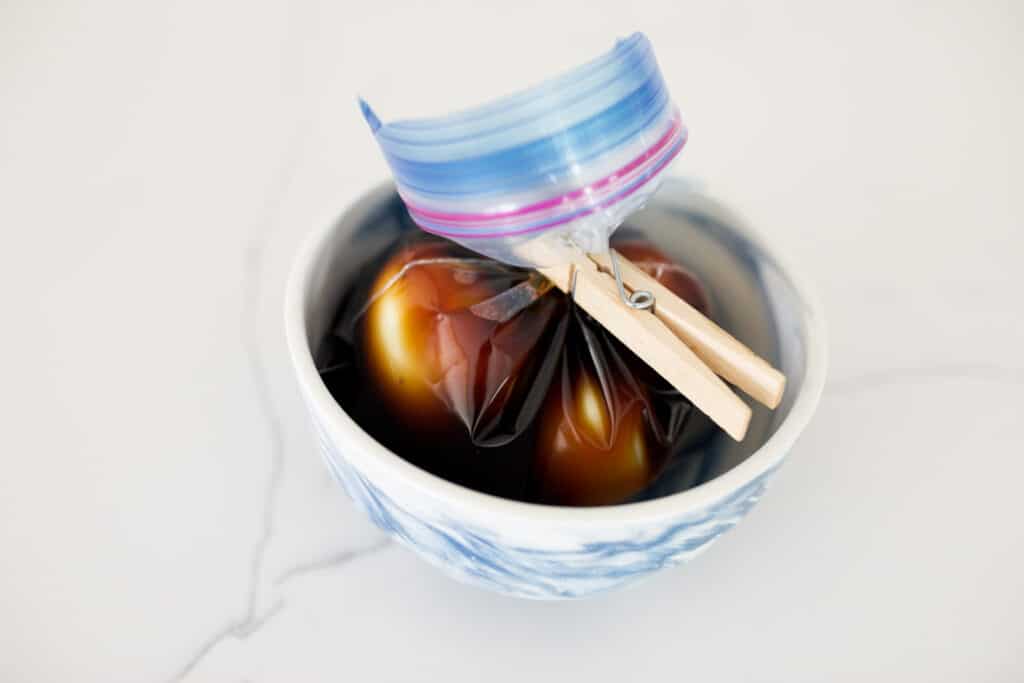
Below you can see the effect on the coloration of the egg marinated in 4 hour increments up to 16 hours. Twelve hours allowed the marinade to penetrate and flavor the egg nicely without affecting the yolk.
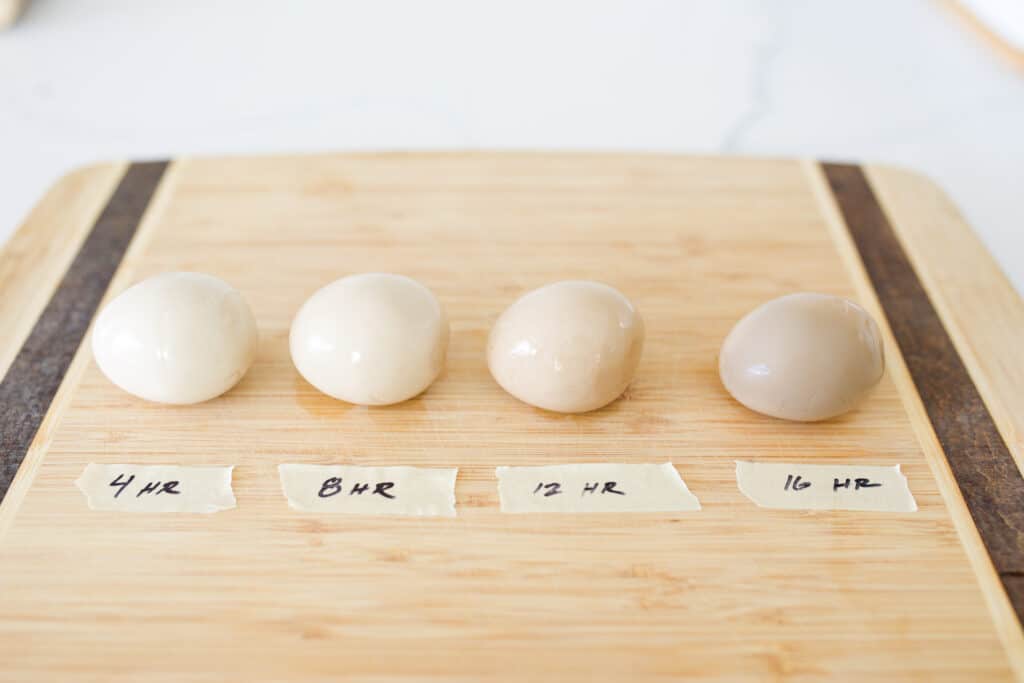
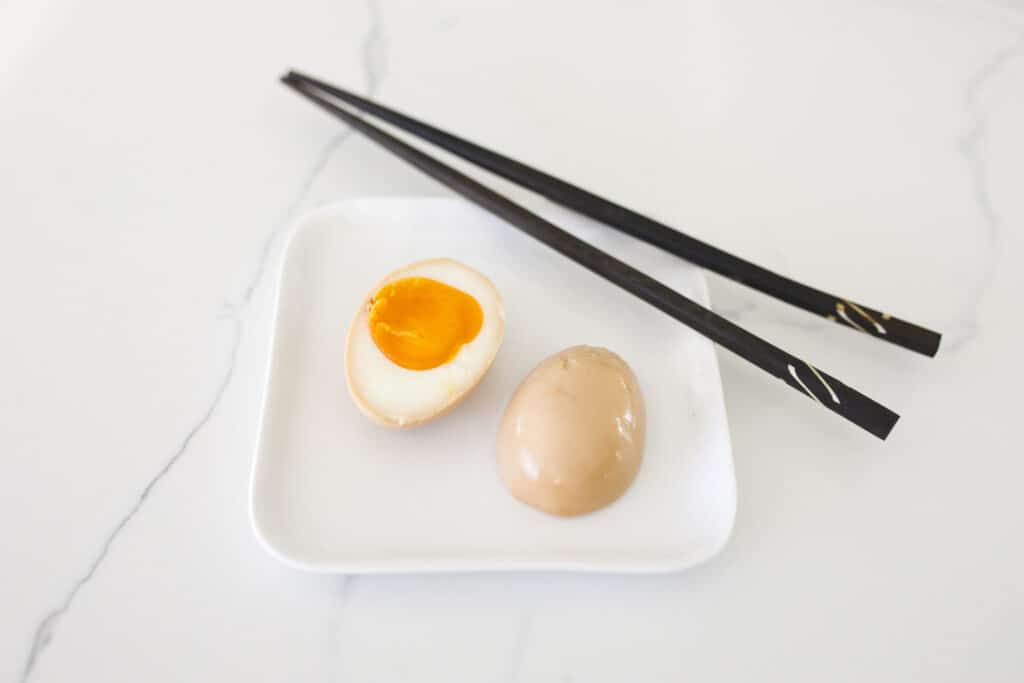
Additional Marinade Ingredients For Ramen Eggs
There’s a lot you can play with to cater to the marinade to your palate. Other ingredients to consider are:
- dashi (fish stock)
- bonito flakes
- dried shitake mushrooms
- chili peppers/flakes
- ginger
- scallions
You can also marinate your eggs in chashu broth on its own if you have it handy.
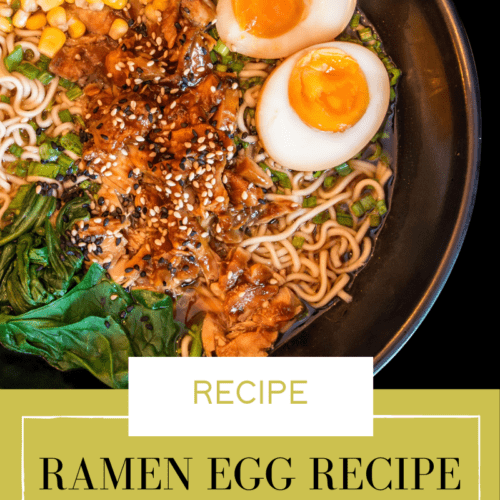
Ajitama Ramen Egg Recipe (sous vide and non sous vide options)
Equipment
- 1 Sous Vide Cooker optional
- 1 Cooking Pot –or– Sous Vide Container
- 1 Large Bowl for an ice bath
- 1 Ziploc bag or airtight container to marinate
- 1 Small Saucepan
Ingredients
For Egg
- 4 large eggs straight out of fridge
- 1 tbsp white vinegar optional – makes peeling eggshells easier
For Marinade
- 1/2 cup mirin
- 1/3 cup sake (or water)
- 1 tbsp sugar
- 1 clove garlic minced
- 1/2 cup soy sauce
Instructions
Three Options for Cooking Eggs
- Sous Vide Method:Preheat water plus 1 tablespoon of vinegar to 194°F (90°C). Prick a hole on the fat end of the egg with a needle or tack and gently drop in the four eggs (shell-on), cooking for 8 minutes and 30 seconds precisely. Immediately chill eggs in an ice bath for ~15 minutes. Gently crack eggshell all around the egg and peel off shells. Be sure to peel off thin membrane on the surface of the egg white.
- Steamed Method:Fill pot with 1.5 inches of water and insert steamer and cover. Boil water to a hard boil.Prick a hole on the fat end of the egg with a needle or tack and add four eggs to steam for precisely 7 minutes. Immediately chill eggs in an ice bath for ~15 minutes. Gently crack eggshell all around the egg and peel off shells. Be sure to peel off thin membrane on the surface of the egg white.
- Boiled Method:Fill pot with 4 cups of water plus 1 tablespoon of vinegar. Bring water to a rolling boil. Prick a hole on the fat end of the egg with a needle or tack and carefully add 4 eggs with a slotted spoon. Lower heat slightly to bring water to a simmer. Immediately chill eggs in an ice bath for ~15 minutes. Gently crack eggshell all around the egg and peel off shells. Be sure to peel off thin membrane on the surface of the egg white.
To Make the Marinade
- Combine mirin and sake in a small saucepan.
- Heat saucepan on medium high heat to a boil. Lower the heat to a simmer and add sugar. Stir to dissolve sugar. Simmer for roughly one minute in total.
- Remove from heat, add minced garlic, and cool completely. Use the fridge to cool if needed.
- Add soy sauce
To Marinate the Eggs
- Place the eggs in a Ziploc bag or airtight container and add the marinade. A Ziploc bag will create the most coverage for the eggs. If you prefer to use a container, you may need to increase the amount of marinade or dilute the marinade with water and marinate it for longer. We want the eggs fully covered in marinade.
- If using a Ziploc bag, squeeze excess air out of the bag and seal. Use a clip or rubber band to pinch the bag just above the eggs to help fully submerge the eggs. Refrigerate in marinate for 12 hours. Eggs may be kept refrigerated 3-4 days.
To Serve
- Cut In half lengthwise. A sharp knife, clean fishing line, or a wire cheese cutter will help keep the cut clean.
Notes
- dashi (fish stock)
- bonito flakes
- dried shitake mushrooms
- chili peppers/flakes
- ginger
- scallions
How Should Ajitama Be Served
Room temperature strikes me as the best option, no matter what you’re eating ajitama with. Of course, do as you wish. But please don’t serve a cold ajitama in your ramen!
Forty-five minutes out of the fridge should suffice to bring the egg to room temperature. To speed up the process you can place eggs in a Ziplock bag and place the Ziplock in warm water.
When served in ramen, the egg is generally cut in half length wise to create ovals showing off the yolk. A sharp knife, some clean fishing line, or a wire cheese cutter like the one pictured below will do the trick.
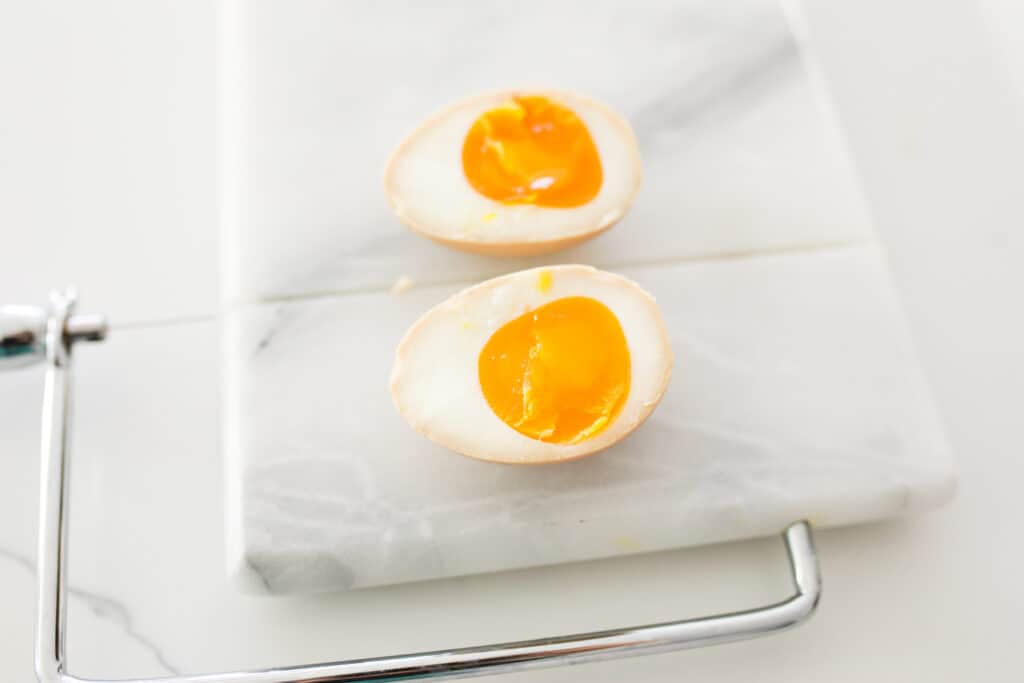
How Long Do Ajitama Eggs Last?
Ajitama can be kept in the refrigerator for up to 4 days.
How Long Does Ajitama Marinade Last?
The marinade will be good for re-use up to 10 days. The marinade can be applied to a variety of foods such as stir fry and fried rice. It can also be used to turn your ramen into shoyu ramen.
Expert Egg Boiling Tips
- Make sure the eggs are fully covered by water in the water bath
- If you’re not using a sous vide, the heavier the pot, the better it will retain heat
- Start peeling the egg from the flatter end of the two ends
- The fresher the egg, the more difficult it will be to peel
- The fresher the egg, the longer it will take to cook
- Place egg in an ice bath immediately after cooking to help cool it quickly and make peeling easier
- Running cool water over the egg from a faucet while peeling can make peeling easier
- Adding white vinegar to the water bath will help make peeling an egg easier. Use 1 tablespoon for a medium size pot. Using a small amount of baking soda instead can help similarly.
Egg Peeling Hack
Working on these eggs left me frustrated at times when peeling the eggs. I turned to the method in the video below with a very high success rate. It’s my go to method now when preparing hard and soft-boiled eggs.
Don’t be afraid to try more than two eggs at a time. I’ve done six at a time in a larger mason jar without any issues.
Note, if you’ve used vinegar in the water, as I’ve suggested in this post, you’ll want to be a touch gentler with the shaking to prevent the egg from falling apart. You can omit the vinegar all together if you plan on using this method to peel the eggs.
Who Invented Ramen Eggs?
We have Kenji Chiba, the owner of Chibakiya, to thank for ramen eggs as we know them today. Before Chiba-san added the halved gooey soft boiled eggs we know and love today to ramen, eggs in ramen were typically hard boiled or sometimes served raw.
Chibakiya opened its doors in 1992 and has grown to several locations. Chibakiya participates in pop-up kitchens in the US where Kenji Chiba can often be found!
If you’re curious about the history of ramen, read here. The country of origin might surprise you.
Ramen Options
Since we’ve emphasized the use of ajitama as ramen eggs, it only seems right we provide a couple ramen options we enjoy.
- Japanese style ramen noodle soup
- Soy sauce flavor
- Item Package Length: 13.97cm
- Item Package Width: 33.02cm
Last update on 2024-04-29 / Affiliate links / Images from Amazon Product Advertising API
Mirin Options
Below you’ll find a mirin option for the marinade recipe provided.
Sake Options
Any sake you have at home will do. I would recommend using a sake you could drink on its own but is relatively inexpensive. If you need a recommendation, Ozeki Yamadanishiki Tokubetsu Junmai is a good option. Junmai (pure rice) sakes in general are a good type of sake to use.
Other Related Recipes
Hungry for more recipes? See below!
- Sous Vide Wagyu Steak Recipe: Foolproof A5 and American
- Sous Vide Ramen Egg – Perfect Onsen Egg
- Starbucks Sous Vide Egg Bites Bacon Gruyere Recipe
- Sous Vide Hard Boiled Eggs, Because You Deserve Better
And if you’re weary of using raw eggs in things like hollandaise or in your favorite bevvie for some texture, just pasteurize your eggs with sous vide.


